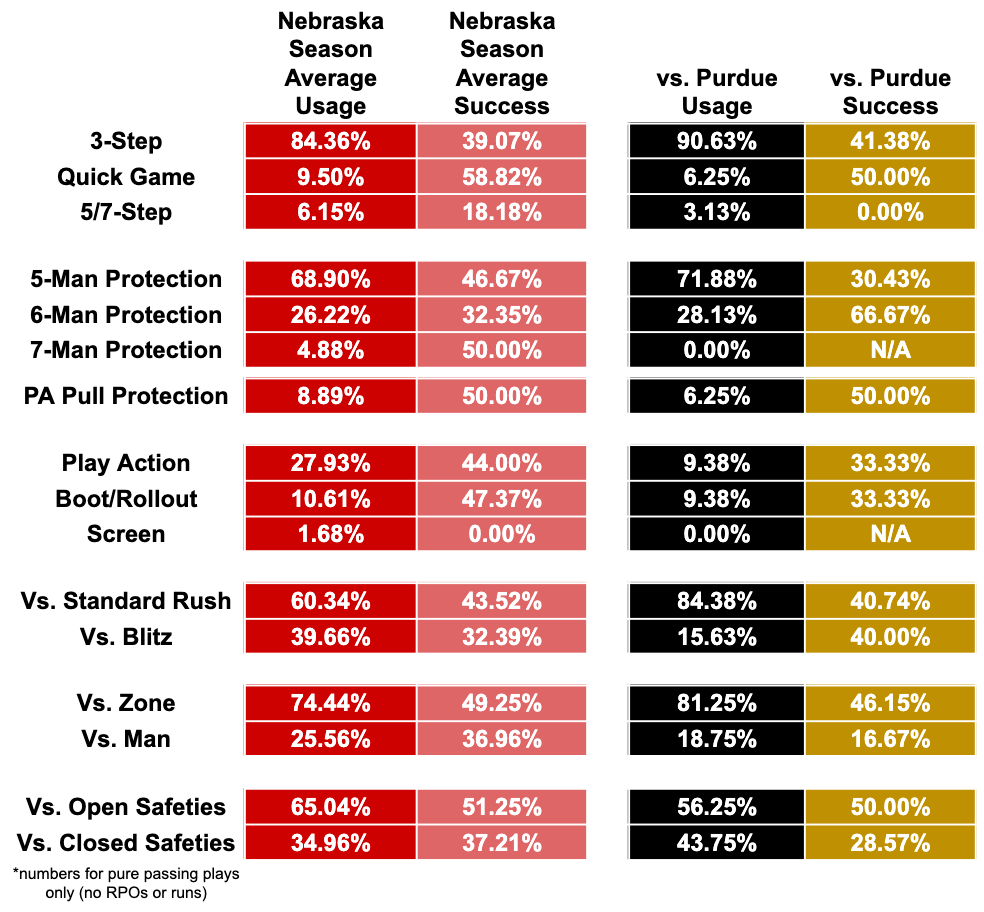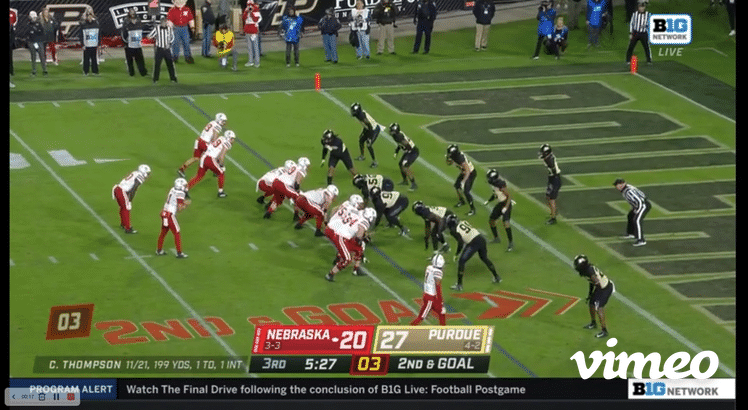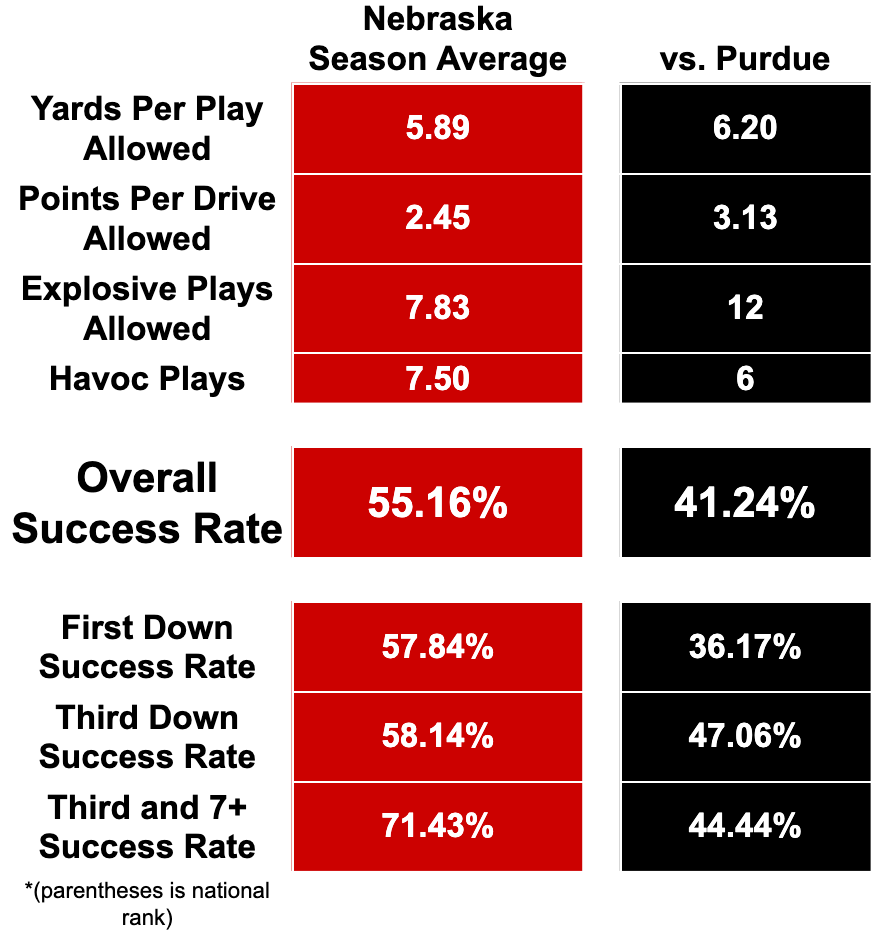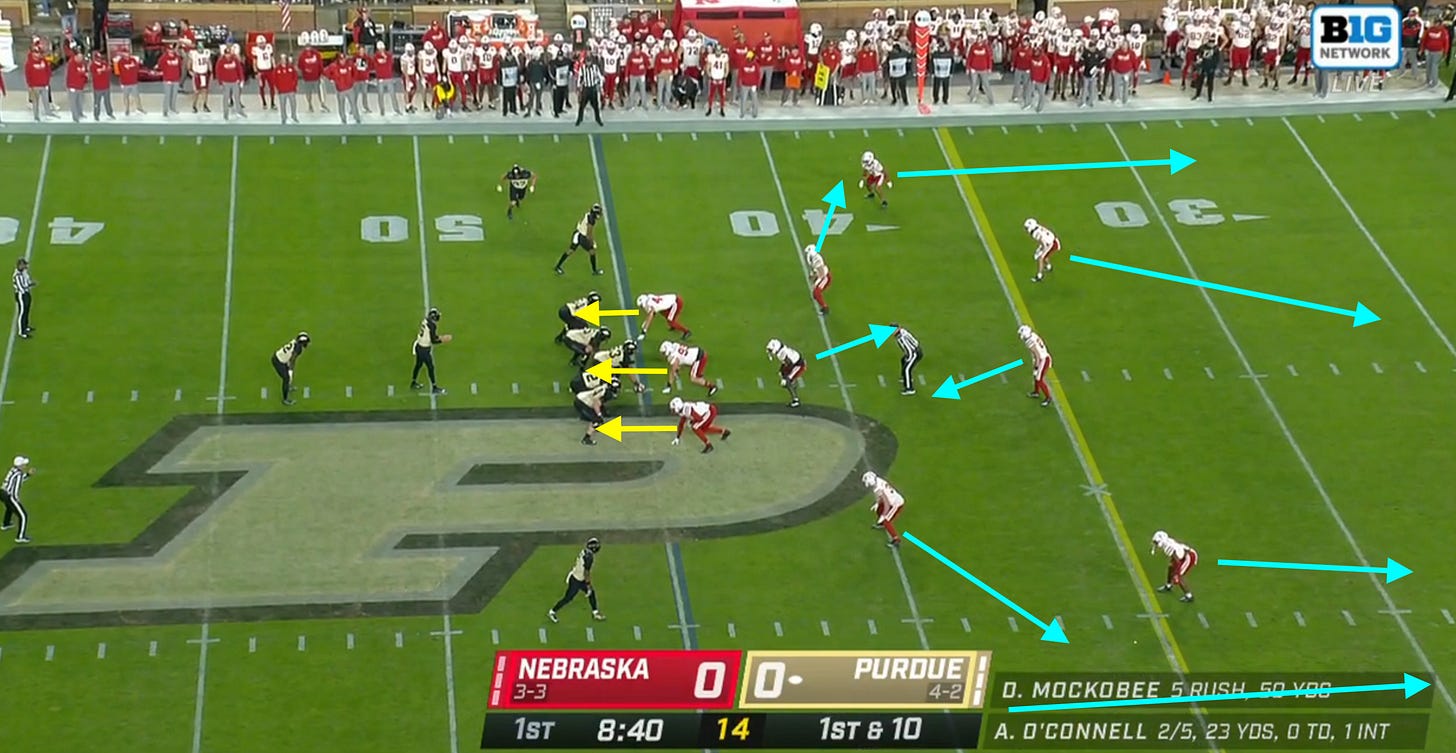2022 PURDUE RECAP: The Trey Palmer Game
Oh wow, hang on, he just ran past another Purdue corner
LIVE LOOK AT TREY PALMER:
With his 237-yard, two-touchdown, Nebraska-single-game-record-breaking receiving performance — not to mention his 60-yard run on an end-around — Palmer now leads the country in receiving yardage. He’s also been one of the highest-graded receivers in the country in advanced metrics, for whatever that’s worth:
This season has mostly sucked, but Palmer and Anthony Grant have both been so, so fun to watch. These guys are awesome! Palmer’s probably on his way to breaking the single-season NU receiving mark. That rocks! I think the general vibe from most Husker fans before the season was confidence in the defense, running game, and some marginal improvement from the offensive line, with deep concern for how the transfer skill players might gel. Well … the transfers are all awesome beyond any reasonable expectation, and everything else has gone off a cliff. I’m not triggered at all!
PROGRAMMING NOTE: If you’re a new subscriber, I would suggest reading the post detailing the newsletter’s plan for this year; it will better explain things like success rate and what the numbers are trying to accomplish.
OFFENSE
GAME CHART
2022 Purdue Offensive Game Chart
OVERALL
Another day, another game where Nebraska’s offense largely underperforms on a down-to-down basis but manages to hit a series of monster plays to salvage its performance. Generating 9.15 yards per play is ridiculous, but take out three catches and one run by Palmer where he went psycho-mode on the defense by himself, NU’s other 48 plays finished with a pretty yuck 4.67 yards per play. I don’t mean to be on some “If You Take Out All The Good Plays They Actually Performed Badly” stuff, but big plays are fickle, and the five defenses remaining on NU’s schedule are all in the top 15 nationally in efficiency. Maybe Palmer keeps playing like a poor man’s Tyreek Hill, but if he doesn’t, this group will need to find some more answers or the next five games are going to get ugly.
Also notable, we saw NU’s pretty good third-down rate begin to regress back to the mean, especially on third-and-longs. That’s been due for a few games.
Some funky stuff going on here against NU’s tendencies, but I’m willing to chalk that up to a small sample size of only 52 plays and that the offense was operating from behind for most of the game.
One personnel thing that I did like was Rahmir Johnson getting into the game at running back for a couple of series (he immediately ripped off a 17-yard run). With Ajay Allen and Gabe Ervin hurt (and even when they’re not), it seems weird and bad to not be using Johnson — one of the fastest players on the team and last year’s de facto starting back down the stretch — in some capacity. This is the same dude who had 170+ yards against Michigan last year; even if Anthony Grant has proven himself to be the starter, not using Johnson for five or so packaged plays a game to take advantage of his juice feels like malpractice.
We also saw Tommi Hill — a starting cornerback for the first four weeks before a low-effort game against OU got him benched — debut at receiver. NU ran a couple designed plays for him in the game that got open but wasn’t able to connect.
RUNNING GAME
Purdue entered Saturday with a top-17 run defense nationally, so it’s not surprising the running game struggled. Nebraska did have some success against lighter boxes (which Purdue was giving them more often than average and probably the reason for the 12/21 personnel decrease). NU also took advantage of an aggressive Purdue rush by utilizing draw plays more often than average; it ran a draw on 4 of its 19 total plays Saturday with a run element, all of which were successful.
A COOL PLAY:
Nebraska has tried a few end-arounds and reverses with little success. One finally worked!
This play was successful because the defense bites hard on the initial action from NU’s offensive line. The left guard and tight end both initially pull to the weak side, making the defense think a GF Counter play is coming. The Purdue middle linebackers suck in to the middle of the formation to fill their gaps and the edge starts to collapse down:
The linebackers REALLY collapse on the (fake) pulling guard and tight end, Nate Boerkircher. But after two steps, Boerkircher reverses field, wheeling back around to lead block on the end-around. Palmer also took an initial jab step downfield to sell the counter play but is now peeling back behind quarterback Casey Thompson as he fakes the handoff to Grant. You can see the corner at the bottom of the screen pointing at Palmer trying to warn his teammates:
Boerkircher keeps rolling down the field as the lead blocker. His kickout block on the playside corner (who is supposed to be the “contain” defender, or widest on the field who forces the play back inside) is what springs the play from a nice first down to a 60-yard run.
Shoutout, Nate Boerkircher.
PASSING GAME
Purdue — which was a blitz-and-man-coverage-heavy team last year — ran a ton of Cover 3 and Cover 4 and rarely brought pressure. I haven’t really watched any of their games this year, so I’m not sure if this was against their tendencies, but that’s a pretty remarkable one-season schematic shift.
I’m still struggling to understand why Nebraska isn’t incorporating more quick-game concepts into the offense, as Thompson has been really good at them all season. I understand wanting to get the ball to the receivers down the field and they should keep doing that, but using more quick-hitting stuff would keep the offense more on-schedule, cover for the offensive line, and keep teams out of playing man coverage, which Thompson struggles against. I feel like that 3 Step/Quick Game ratio should be something like 75/20 instead of 85/10.
Nebraska’s pass game was glitchy in the first half until it honed in on an effective strategy: Chuck it deep. NU called some variation of verts on a third of its plays Saturday; what has normally been a designer 3-Step passing game pretty quickly became bombs away when the staff figured out no one was staying in front of Palmer.
Nebraska seemed to be specifically trying to attack Purdue’s corners in Cover 4, which Purdue played on half of NU’s passing plays. A lot of Nebraska’s concepts in the second half involved trying to isolate Palmer on Purdue’s corners by forcing “lock”s against Cover 4. That’s what happened on the long touchdown in the third quarter:

I’ve talked a lot about the basics of Cover 4 in past newsletters, but I’ll do it again: Cover 4, or Quarters, is a deep zone coverage that divides the field into 1/4s by the two outside corners and two safeties. Here, Purdue lines up in a two-safety-high shell, indicating it’s likely to be playing Cover 4 instead of Cover 3 (the other coverage it was frequently running, which typically features only one safety lined up deep at the snap):
Cover 4 is ostensibly a zone coverage, but to prevent deep crossing-the-field routes from burning it, most defenses have rules where secondary players will “lock” onto receivers if the a receiver in their zone get deep enough (usually about 10 yards), turning into de facto man coverage after that point. That’s what Nebraska tried to take advantage of here:
The inside receiver to the play side of the concept immediately threatens the Purdue safety vertically, locking the Purdue safety onto him in man-to-man coverage; that’s now his guy, he’s out of the play and getting pulled away from Palmer. Palmer, lined up as the outside receiver, initially breaks outside on what looks like a quick out route. The corner over him is still playing zone with his eyes on the quarterback and not turning his hips to treat Palmer as a potential deep threat. But that’s about to happen:
Palmer’s initial out-route fake quickly gets turned upfield on a sort of short wheel route. The corner, who had been tricked into playing a slow backpedal in zone coverage with just an out route in front of him, is now realizing he’s responsible for playing Palmer one-on-one deep and is totally unprepared and out of position, still facing the quarterback and already without any cushion. He has no chance the rest of the way.
The other way they attacked the “lock” principle was through running sideline-area stop routes from the outside receiver, with Palmer aligned in the slot coming around behind it and then going vertical:
Palmer doesn’t get the ball here out of the slot, but the threat of him going vertical causes the secondary to bail fast, opening up the underneath curl for Marcus Washington. You also saw this stop-wheel concept on the fake screen Thompson threw the interception on. Doing this adds the element of the secondary players having to switch assignments as the outside receiver comes on an inside route and the inside receiver comes on an outside vertical route.
One other passing game thing I noticed Saturday was the pass releases by Nebraska’s running backs. They typically just swing out into the flat horizontally for a check down but were incorporating having the running back turn the flats upfield into some wheel routes against Purdue:
And here’s the former cornerback Hill doing it on one of the plays they designed for him (which ends up being a disaster because the back’s immediate release leaves it as a five-man protection against a nickel blitz from Purdue):
The goal of a wheel route is to get the defender to jump on the flat route before you turn it upfield and blow past them. With Nebraska running so many flats from it’s running backs, this was a smart curveball here by Whipple to try to spring a big passing play, even if it didn’t work in the handful of times NU tried it.
DEFENSE
GAME CHART
2022 Purdue Defensive Game Chart
OVERALL
BAD DEFENSE IS BACK! After two promising games by the Blackshirts, a pretty average Purdue offense torched Nebraska in basically every category: in the run, in the pass, on early downs, on money downs, with big plays, by preventing mistakes. Most of Nebraska’s stops came when a Purdue receiver dropped a pass. Some of that was because Aidan O’Connell was on an insane heater (which he always seems to be against Nebraska???) and played essentially a perfect game of quarterbacking after the first series’ interception. After two games where NU got away with its new aggressive defensive play style because Indiana’s and Rutgers’ quarterbacks couldn’t make it pay, O’Connell ran them over with the regression bus.
I doubted if the aggressive press Cover 1 looks Bill Busch had been using would be effective against a better quarterback, and to his credit, he did adjust in an attempt to slow O’Connell; it just didn’t work.
Busch’s main adjustment was to incorporate a lot more “Drop 8” coverages — meaning eight players in pass coverage with only three rushers (NU’s base allocation is four rushers with seven coverage players):
Purdue (mostly because of O’Connell and a lack of pressure) had a 68% success rate against the Drop 8 looks. Busch did try a curveball, but it got blasted into the upper deck.
NU also tried to utilize some three-safety looks as part of the Drop 8 packages. The three-safety stuff has become increasingly in-vogue in college football, popularized by coordinator Jon Heacock at Iowa State under Matt Campbell in an attempt to slow down the Big 12’s Air Raid offenses. New head coach Brent Venables switched OU to the scheme this season.
The look is essentially a 3-3-5 (three down linemen, three linebackers, and five secondary players) but takes the normal “Nickel” player and replaces them with a third safety deep (circled in blue). This is tricky because the middle “robber” safety is a wild-card pre-snap: he can drop deep as part of a three-cloud coverage, he can come up and play a “robber” technique in the short middle of the field, he replace one of the other safeties if they blitz, he can blitz himself, or he can shift late into the box and act as a fourth linebacker. It’s tricky to the quarterback pre-snap.
To run this defense, though, you’ve got to be elite on the defensive line and have players who can occupy multiple gaps, which I think we’ve seen NU doesn’t.
I hadn’t seen any three-safety looks from Nebraska all season, but this is an interesting package that I hope to see more of in the future as a curveball from Busch.
That’s it for this week! There will be no post next Friday because of the bye week. Comments or questions are open below!
If you’re enjoying this newsletter, feel free give it a share to another Husker sick who might like it or post it in a community! GBR.


























